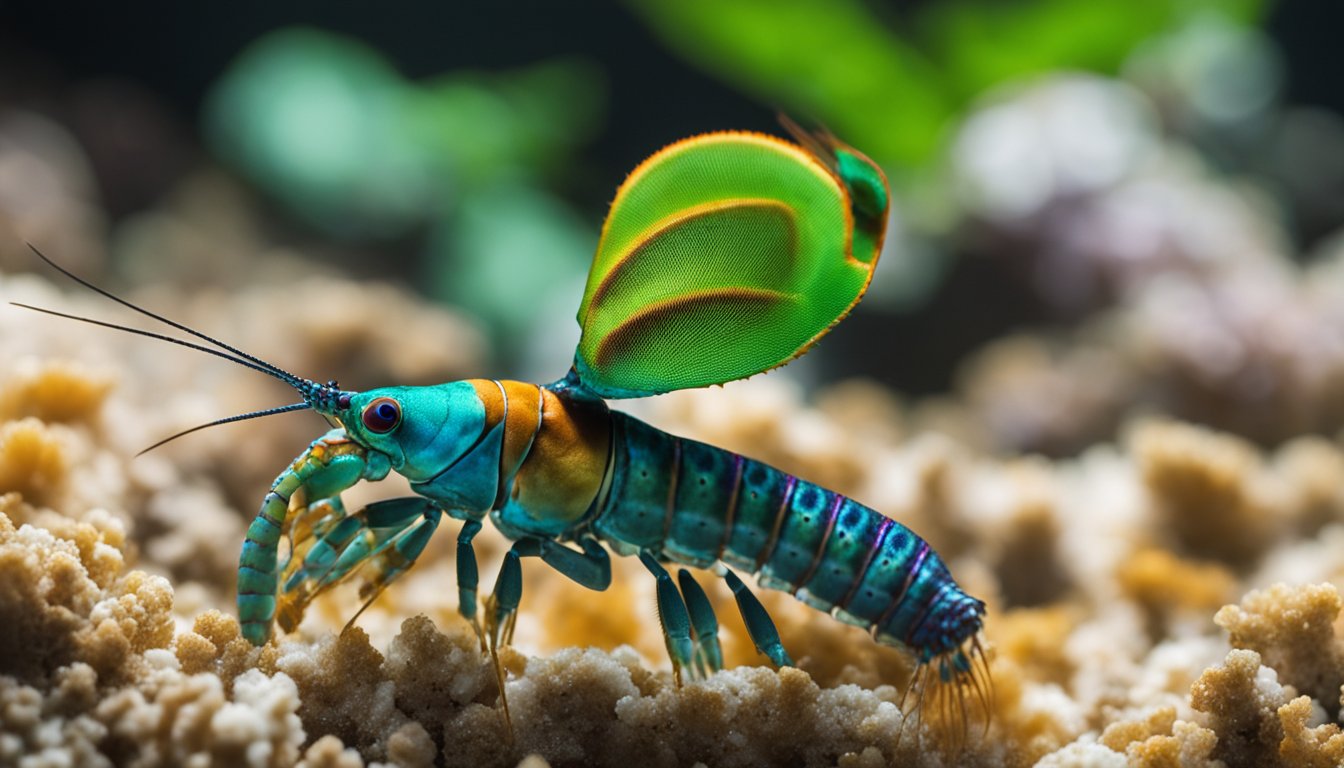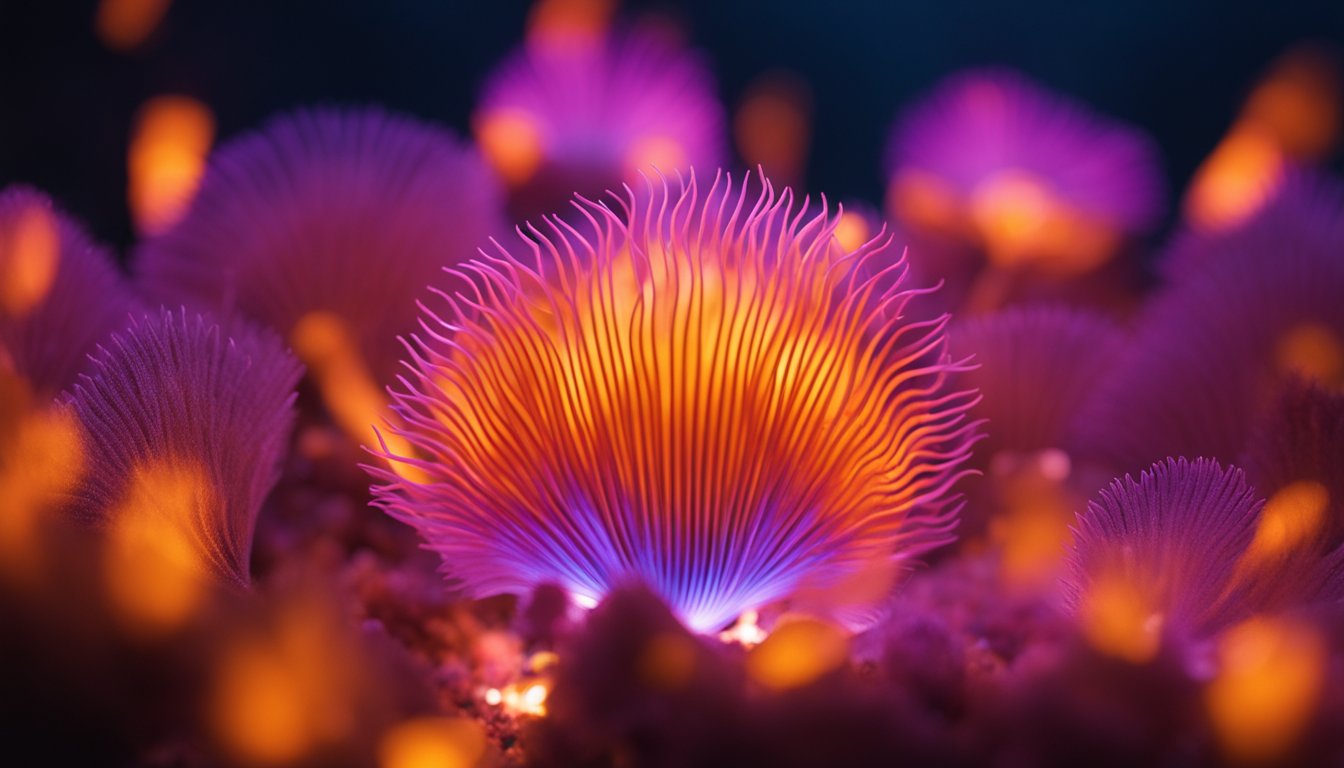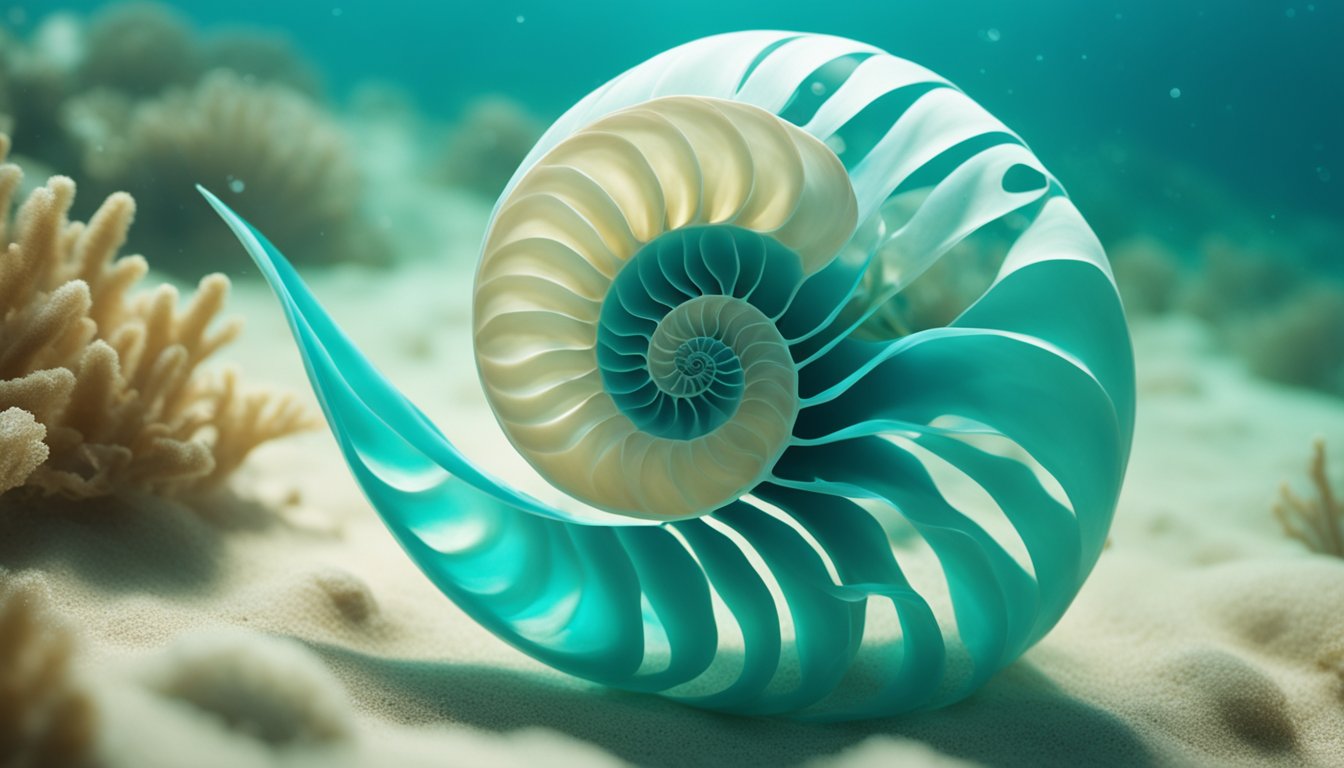Imagine if we could light up the night with our bodies, no flashlight needed. That’s exactly what the Hawaiian Bobtail Squid does!
These small squids, found in the shallow waters of Hawaii, carry their own little flashlights, thanks to some helpful bacteria.
By hiding their shadows with this glow, they can sneak around without being spotted by predators from below.

Our tiny friend is not much bigger than a grain of rice when it’s born, growing to be as big as a lemon.
They play a really cool game of hide-and-seek with light. During the day, they bury themselves in the sand to nap, and at night, they come out to hunt.
But here’s the secret: they glow to match the moonlight on the water’s surface, blending in so well that it’s hard for any hungry fish to spot them.
The Hawaiian Bobtail Squid has a special light organ inside its body that is home to the bacteria. It’s like having a belly full of stars!
These bacteria get a safe place to live, and in return, they help the squid light up. Isn’t it amazing how two different creatures can work together like that?
It’s like having a built-in night-light because we might be a little afraid of the dark, but this clever squid? Not one bit!
Discovering The Hawaiian Bobtail Squid

Our little glowing friends, the Hawaiian Bobtail Squids, are quite the spectacle in the marine world, with their unique partnership with luminescent bacteria.
Habitat and Distribution
We find our Hawaiian Bobtail Squid primarily in the shallow waters of the Pacific Ocean, nestled around the Hawaiian Islands.
They love sandy seabeds and seagrass meadows where they can easily burrow and hide from predators during the day.
At night, they come out to play and feed, lighting up the water with their bioluminescent glow.
Imagine them as tiny underwater lookouts, flickering like stars in the sea as they look for their dinner.
Physical Characteristics
When we talk about the physical characteristics of the Hawaiian Bobtail Squid, it’s like describing a pocket-sized underwater marvel.
These squids are small, typically no larger than a lemon.
They aren’t just cute; their bodies are fascinating! They house light-producing bacteria within a special organ in their mantle, which helps them camouflage perfectly against moonlit water.
With a soft, rounded body, they blend into the ocean’s backdrop, becoming nearly invisible to both prey and predators alike.
Their eight arms and two tentacles are not only tools for movement and feeding but a spectacle when they change colors and patterns to communicate or startle others in the deep blue.
Symbiosis with Bioluminescent Bacteria

We’re about to explore a remarkable partnership between the Hawaiian Bobtail Squid and tiny glowing bacteria.
This relationship is a brilliant example of nature’s ingenuity.
The Magic of Light Production
Inside the squid’s body, there’s a special light organ that houses bioluminescent bacteria called Vibrio fischeri.
These bacteria are like little living lanterns. We can imagine them as the squid’s personal nightlights.
They produce a soft glow by using a chemical reaction that involves a molecule named luciferin, an enzyme called luciferase, and oxygen.
When these combine, they create a reaction that emits light, illuminating the night sea just enough for the squid to thrive without being too obvious to predators.
Benefits of Bioluminescence
Our friend, the Hawaiian Bobtail Squid, is quite the night-time strategist thanks to bioluminescence.
By partnering with Vibrio fischeri, the squid gains a form of camouflage called counterillumination.
The squid adjusts the intensity of the bacteria’s light to match the moonlight, making its underside glow.
This neat trick fools predators below into thinking the squid is just another star in the sky, so they swim right past without noticing.
Plus, the light show isn’t just for defense; it helps the squid hunt, too.
By breaking up its silhouette, it becomes a stealthy hunter, sneaking up on its next meal.
Isn’t it fascinating how these tiny bacteria help our squid buddy by sharing their natural glow?
They get a safe home and nutrients in return—a win-win in the deep blue!
Behavior and Lifestyle

In the depths of the ocean, we find the Hawaiian Bobtail Squid leading a secretive life.
This clever little mollusk has evolved some unique behaviors that allow it to thrive where others might not.
It hunts like a stealthy ninja and hides from predators using an incredible disappearing act!
Hunting Tactics
When we go out to seek our dinner, we don’t camouflage ourselves and emit light to attract prey, but that’s exactly what the Hawaiian Bobtail Squid does.
This remarkable creature buries itself in the sand during the day and ventures out at night to hunt.
It uses a specialized organ that houses bioluminescent bacteria to create a glow underneath its body.
This glow helps to mask its silhouette from anyone lurking below, a strategy known as counter-illumination.
By adjusting the intensity of this light to match the moonlight, the squid becomes nearly invisible to both prey and predators looking up from the depths.
Camouflage and Predation
Did you know that the Hawaiian Bobtail Squid is also a master of disguise?
It has the extraordinary ability to change its skin color and texture to blend in with its surroundings, thanks to special cells in its skin called chromatophores, leucophores, and iridocytes.
But even with its color-changing tricks, the squid isn’t always the hunter; sometimes it’s the hunted.
To avoid becoming a midnight snack for larger sea creatures, our squid buddy burrows into the sand during the day to sleep, using only its eyes to peek out for any signs of danger.
It’s a fascinating cycle of eat or be eaten—always keeping one step ahead of the game.
Reproduction and Life Cycle

As we explore the fascinating life of the Hawaiian Bobtail Squid, we’ll find that their reproduction process and growth stages are captivating.
These glow-in-the-dark creatures have unique rituals to attract mates and an incredible journey from hatching to maturity.
Mating Rituals
When we think about how animals find each other in the vast ocean, it’s like looking for a friend in a massive stadium!
But Hawaiian Bobtail Squid have a special trick.
During mating, males show off their glowing undersides to catch the attention of potential female partners—think of it as a neon sign saying, “Hey, look at me!” After captivating a female with this light show, the male deposits packets of sperm, called spermatophores, directly into the female’s body.
Females then lay their eggs, often on the undersides of rocks or in hidden crevices to keep them safe from predators.
It’s like playing the ultimate game of hide and seek with their future babies!
Once the eggs are laid, the female’s job is done, and she leaves the eggs to hatch on their own.
Growth and Development
Imagine jumping into life already knowing what to do! That’s the story for Hawaiian Bobtail Squid hatchlings.
They hatch fully developed, like tiny adults, knowing how to hunt and use their built-in flashlight—a special light organ powered by bioluminescent bacteria.
Within a few hours of hatching, they find and partner with these helpful bacteria, starting a lifelong friendship.
Even though they’re born ready to tackle the world, hatchlings continue to grow until they reach adulthood in about three to five months.
That’s super fast, like growing from a baby to a grown-up over a long summer holiday.
Sadly, after fulfilling their role in the circle of life by reproducing, Hawaiian Bobtail Squids usually live only six to eight months.
Our little glowing friends show us the beauty and brevity of life in the ocean’s depths.
Conservation Status and Human Impact
Before we explore the deeper waters where the Hawaiian Bobtail Squid thrives, let’s talk about its place in the ocean and how we might affect its twinkling existence.
Environmental Challenges
Our Hawaiian Bobtail Squid friends face a sea of challenges in their natural habitat.
Imagine a little squid, no bigger than a lemon, trying to navigate through a vast underwater world full of big changes.
Pollution, such as plastics and chemicals, can make their homes less cozy and more dangerous.
Plus, changes in sea temperatures can mess with their ability to hide using their glow-in-the-dark superpowers, since the tiny bacteria that help them light up are very sensitive to temperature.
Conservation Efforts
Now, while these issues might seem as deep as the ocean, fantastic people all around the world are helping to protect our shimmery companions.
Conservation efforts, including marine protected areas and pollution control, are like lifeboats for these squids.
Experts are also working hard to learn more about the Hawaiian Bobtail Squid, because understanding our small pals is a big step in making a safe space for them in the ocean.
By keeping our beaches and waters clean, we become part of the squid squad, helping to keep their glow bright and their future sparkling!
Frequently Asked Questions
Dive with us into the magical world of the Hawaiian Bobtail Squid, a twinkling wonder of the ocean.
Let’s learn how this tiny creature uses light in the most clever ways, and find out all about its special friendship with some luminescent partners!
Why does the Hawaiian Bobtail Squid light up like a tiny underwater star?
The Hawaiian Bobtail Squid shines underwater because it has a special organ in its body that houses glowing bacteria called Vibrio fischeri.
Together, they create a chemical reaction that produces a beautiful, bluish light.
This light mimics the moonlight or starlight that touches the water’s surface, making the squid invisible from below and thus protecting it from predators.
What’s the super cool partnership between the Hawaiian Bobtail Squid and its glowing bacteria buddies?
Our Hawaiian Bobtail Squid forms a symbiotic relationship with Vibrio fischeri bacteria.
These bacteria live in the squid’s light organ, and in return for a secure home and nutrients, they emit a light that camouflages the squid.
It’s like having roommates that pay rent by turning on the lights.
How does the Hawaiian Bobtail Squid’s personal light show help it survive in the ocean?
This light display is not just for show. By glowing, the squid casts no shadow and blends with the moonlight, creating an effective camouflage.
This technique, known as counter-illumination, makes it nearly invisible to predators and prey, allowing it to ambush its dinner and stay safe.
What is the secret behind the dazzling light of the Hawaiian Bobtail Squid?
The secret is bioluminescence! The squid’s light comes from bacteria that are experts in this glowing trick.
They use an enzyme called luciferase to oxidize a compound called luciferin, which, together with oxygen, produces light.
This reaction is fine-tuned so the squid can control the intensity and even the on-off switch of the light.
Is the Hawaiian Bobtail Squid really as small and cute as it sounds?
Absolutely! Despite its magnificent light, the Hawaiian Bobtail Squid is quite tiny, fitting comfortably in the palm of our hand.
It’s just two to three inches long, but don’t let its size fool you. This mighty mite is an oceanic marvel.
How do glimmering bacteria get a cozy home inside the Hawaiian Bobtail Squid?
These glowing bacteria find their housing through a fascinating process.
As larvae, squid are bacteria-free, but once they hatch, they release a sugar and protein cocktail from their light organ to attract bacteria.
Among millions of bacteria in the water, only Vibrio fischeri gets to enter and stay, turning the squid’s light organ into a glowing haven.




